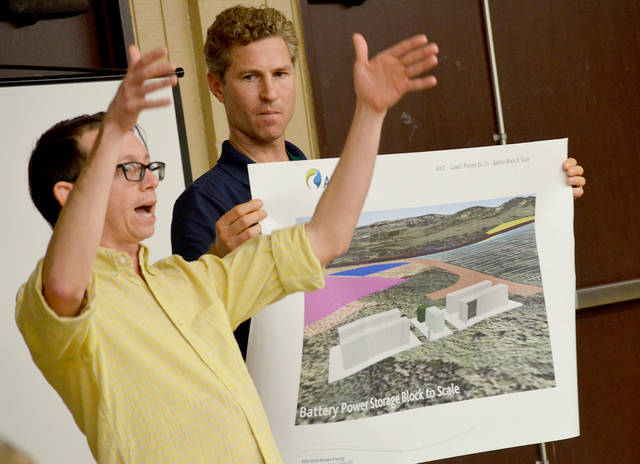LAWAI — A solar project about twice the size of the Tesla facility is set for Lawai and if all goes according to plan, the array will be delivering power to Kauai’s grid by year’s end.
The project is located on A&B-leased land. AES Distributed Energy owned and maintained equipment will provide 20 megawatts of energy for five hours after sundown for a total of 100 megawatt hours.
“The project will provide 11 percent of Kauai’s electric generation; increasing Kauai Island Utility Cooperative’s renewable sourced generation to close to 60 percent,” said David Bissell, KIUC president.
For comparison, the Tesla facility provides 13 MW for four hours, for a total of 52 MWh.
KIUC will operate the system and buy the power through a fixed purchase power agreement, at 11 cents per kWh.
“The pricing is well below the cost of diesel and will not only provide downward pressure on rates, but also helps us avoid the use of 3.7 million gallons of diesel each year,” Bissell said.
All of the energy generated from the AES Lawai Project will go to KIUC, according to Sam Ley, energy systems engineer, who brought the public up to speed on the project Thursday night.
Dianna and Kelley Phillips were among the about 20 people that attended the meeting at the Koloa Neighborhood Center, and they dropped by because their home is across the street from the construction and staging area on Koloa Road.
An increase in traffic on Koloa Road was a main concern for the couple. Ley said he and AES representatives on-island would talk further about their recommendations for the project.
“Traffic is a problem on Koloa Road,” Dianna Phillips said. “It should be considered.”
Traffic management plans are under review, according to Cameron Haughey, project manager.
Other concerns raised during that meeting revolved around dust generation, access and roadway improvements and the details of the solar array, which is under a 25-year agreement with KIUC.
Fishing in the surrounding reservoirs was a point of question at the meeting, and AES representatives said they’re aware that the reservoir near the part of the property they’re leasing is popular.
“The area we are leasing is contained inside the property,” Ley said. “(We’ll have) a seven-foot fence around the leased area, but there’s still a lot of property not under our control.”
The solar photovoltaic (PV) system that’s planned for the project will be fully integrated with the Battery Energy Storage System (BESS) and the energy from the solar will be stored either in the BESS or delivered directly to the grid.
The stored energy will be used by KIUC during evening peaks and to provide consistent nighttime power.
Construction is set to begin in this summer, and AES will be building eight power blocks, each operating independently and it will be built so the land can be simultaneously used for agriculture.
“The system generates all the power it needs to power itself and the wiring through the project is underground,” Ley said. “There’s the secondary agricultural usage for the property — in this case, vegetation management with sheep under the array.”
And after 25 years, Ley said AES will take a look at the array and evaluate the possibility of renegotiating the lease if it is still usable.
“We do have an obligation to remove all operations, scrape the land clean, and return it to ag (at the end of the agreement),” Ley said. “And there’s a possibility we keep it going.”


